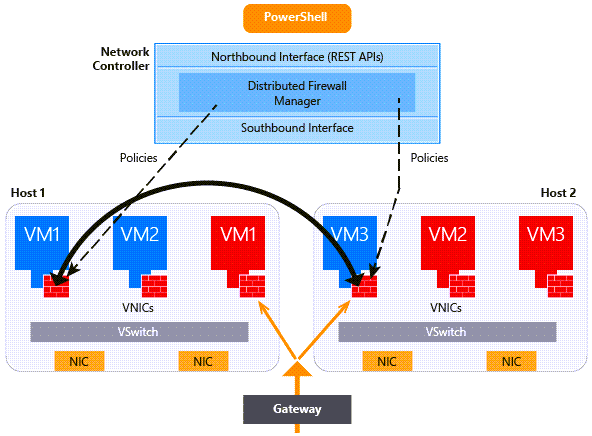What is Datacenter Firewall?
Applies to: Azure Local 2311.2 and later; Windows Server 2022, Windows Server 2019, Windows Server 2016
Datacenter Firewall is a network layer, 5-tuple (protocol, source and destination port numbers, source and destination IP addresses), stateful, multitenant Software Defined Networking (SDN) firewall. The Datacenter Firewall protects east-west and north-south traffic flows across the network layer of virtual networks and traditional VLAN networks.
How Datacenter Firewall works
You enable and configure Datacenter Firewall by creating network security groups (NSGs) that get applied to a subnet or a network interface. Firewall policies are enforced at the vSwitch port of each tenant virtual machine (VM). The policies are pushed through the tenant portal, and Network Controller distributes them to all applicable hosts.
Tenant administrators can install and configure firewall policies to help protect their networks from unwanted traffic originating from internet and intranet networks.
The service provider administrator or the tenant administrator can manage Datacenter Firewall policies via Network Controller and the northbound APIs. You can also configure and manage Datacenter Firewall policies using Windows Admin Center.
Advantages for cloud service providers
Datacenter Firewall offers the following advantages for cloud service providers:
A highly scalable, manageable, and diagnosable software-based firewall solution that can be offered to tenants
Freedom to move tenant VMs to different compute hosts without breaking tenant firewall policies
Deployed as a vSwitch port host agent firewall
Tenant VMs get the policies assigned to their vSwitch host agent firewall
Firewall rules are configured in each vSwitch port, independent of the actual host running the VM
Offers protection to tenant VMs independent of the tenant guest operating system
Advantages for tenants
The Datacenter Firewall offers the following advantages for tenants:
Ability to define firewall rules to help protect internet-facing workloads and internal workloads on networks
Ability to define firewall rules to help protect traffic between VMs on the same Layer 2 (L2) subnet and between VMs on different L2 subnets
Ability to define firewall rules to help protect and isolate network traffic between tenant on-premises networks and their virtual networks at the service provider
Ability to apply firewall policies to traditional VLAN networks and overlay-based virtual networks
Next steps
For related information, see also:
